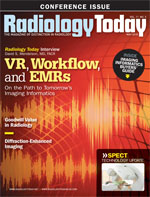May 2010

Outsourcing Equipment Acquisition — Providing Facilities Flexibility to Get the Equipment They Need
By Ray Stachowiak
Radiology Today
Vol. 11 No. 5 P. 10
Lingering economic uncertainty and the tight credit market keep hospitals and other imaging facilities intensely focused on cash flow. The impact of recently signed healthcare reform legislation creates its own uncertainties about the future healthcare marketplace. It’s understandable in this environment that capital purchases of new CT, MRI, PET/CT, and other imaging equipment would take a backseat.
Many hospitals are in a defensive posture regarding investing in future growth. But invest they must because one way or another, healthcare reform is likely to increase the number of individuals covered by insurance, raising the demand for healthcare services.
So how can hospitals pursue their growth goals and meet the imaging needs of their communities while keeping a tight leash on capital budgets? The answer for some facilities is to work with an outsource provider that can assess a hospital’s diagnostic needs, recommend an appropriate solution, and offer greater financial flexibility in acquiring state-of-the-art equipment. The solution may involve a mobile service, an on-site lease at a fixed monthly cost, or a new purchase that includes a service and maintenance component. These alternatives can help hospitals keep up with technology, meet their imaging demand, and maintain or increase revenues while minimizing their risks and holding down costs.
Durham Regional Hospital
Facilities of all sizes, including those with significant capital, have found working with an outsource equipment provider useful for bringing advanced imaging technology into their communities while holding down costs. Durham Regional Hospital, a 369-bed acute care hospital that’s part of the Duke University Health System in North Carolina, has been working on a $3 million expansion of its CT suite. The expansion will bring the space to 2,500 square feet and add two new 64-slice Siemens CT scanners, including software for all CT angiography (CTA) procedures, perfusion studies, and CT fluoroscopy.
Gregory Thon, director of radiology at Durham Regional, says the hospital’s two existing 4-slice GE CT scanners, both more than a decade old, have become outdated. The hospital has the capital budget for the expansion and the upgraded equipment, but the new scanners would not be up and running for at least six months after construction began. Durham Regional sought to fill that gap by working with imaging outsourcing firm Shared Imaging, LLC, a provider of CT, MRI, and PET/CT systems. After an analysis of Durham Regional’s needs, Shared Imaging recommended a six-month lease of a GE BrightSpeed 16 in a mobile configuration to fill the gap. The move added CT scanning capacity during the construction and represented a leap forward in technology for the hospital and its patients until the 64-slice scanners were installed.
“It was a big opportunity for us to add volume that we couldn’t handle otherwise,” says Thon. “If a physician thought a CT angiography was important for a patient, we would have had to refer them somewhere else until the new scanners were up and running. But now we can do it right here at the hospital. It’s additional revenue for us, and it’s more convenient for patients as well.”
Thon says the hospital has seen a 2% to 3% increase in the volume of CT scans since bringing in the mobile CT. CTA volumes are up 300% for some studies.
Thon says the cost structure of leasing through Shared Imaging was also attractive to Durham Regional. “With the mobile configuration and lease arrangement, we’re getting access to top-quality technology as an operating expense rather than a capital cost,” he says. “In this economy, for our temporary situation, it was the only way we could have maintained volumes.”
By using the GE BrightSpeed 16, Durham Regional physicians and other staff are also becoming acquainted with more advanced CT technology, providing a better transition to the new permanent scanners the hospital will install.
“Our referral physicians are getting a better handle on what they can expect going forward with the new scanners we’re going to install—the scope and capability of new equipment,” Thon says. “Having access to a top-of-the-line mobile CT has helped us open doors and shine a light on important developments in care at Durham Regional.”
Selecting a Provider
Durham Regional’s experience is one example of how an outsource provider can help hospitals meet today’s challenges with respect to imaging and radiology equipment. Rather than taking on the locked-in costs and risks of a capital purchase of new equipment that may quickly become outdated, hospitals can keep up with rapidly advancing imaging technology and increasing demand while keeping their options open through mobile services, leasing, and other methods.
If your facility is considering contracting with an outsource provider for CT, MRI, or PET/CT equipment, your decision will probably begin and end with cost—and rightly so. However, there are other attributes you should look for, including the following:
• The best equipment outsource partners will provide comprehensive support to ensure you make the most of your system at no extra charge.
• The effort should start with a thorough assessment of current and future imaging needs.
• Delivery, installation, complete training, and all service and preventive maintenance should be included in any agreement.
• If you haven’t already done so, pursue accreditation for insurance reimbursement related to diagnostic imaging equipment. Beginning on January 1, 2012, to qualify for Medicare reimbursement payments, suppliers of advanced diagnostic imaging services must be accredited by an organization designated by the Centers for Medicare & Medicaid Services, such as The Joint Commission. Make sure your provider is certified, not only because it’ll ensure Medicare reimbursement but also because it’s a great way to further reduce risks and ensure quality for your patients.
— Ray Stachowiak is president of Shared Imaging, LLC.

